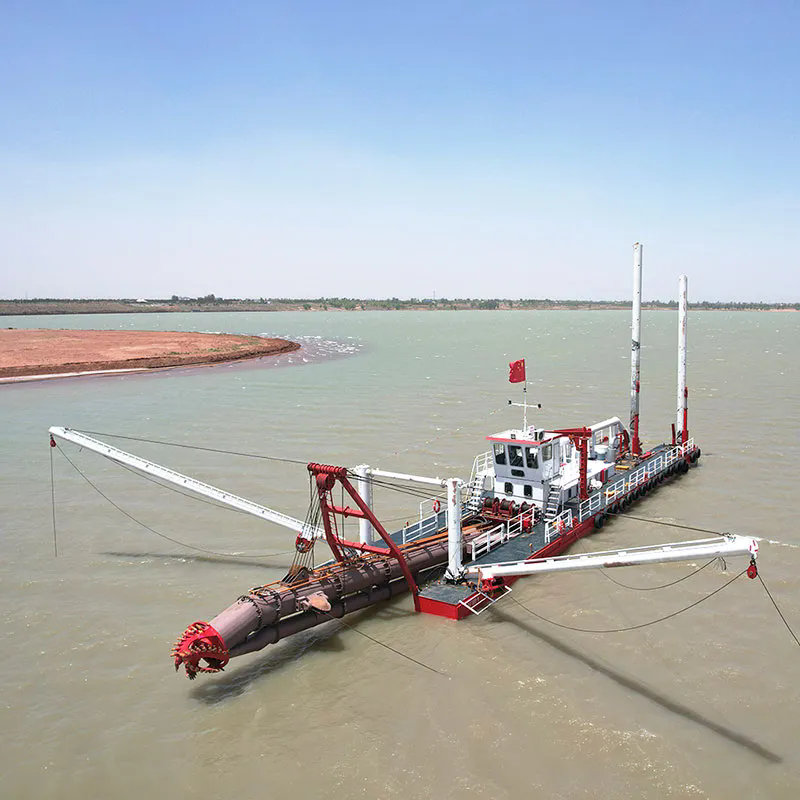What Makes a Cutter Suction Dredger Essential for Modern Dredging Projects?
2024-11-13
Dredging has been an essential part of maintaining and expanding waterways, harbors, and ports for centuries. Among the various types of dredging equipment, the Cutter Suction Dredger (CSD) stands out as one of the most efficient and versatile tools in modern dredging operations. But what exactly makes the CSD such an indispensable machine for large-scale dredging projects, and why is it so widely used in industries like marine construction, environmental restoration, and infrastructure development?
What is a Cutter Suction Dredger?
A Cutter Suction Dredger is a type of dredging vessel designed to excavate material from the bottom of bodies of water, such as rivers, lakes, and oceans. The dredger is equipped with a rotating cutter head mounted on the end of a suction pipe. This cutter head is used to loosen and cut into the seabed or riverbed, while the suction system then draws the loosened material up the pipe and onto a discharge area, either to be relocated or removed from the water.
The Cutter Suction Dredger is a stationary, self-propelled unit that can operate in a wide range of water depths and is often used for dredging in deep or confined spaces where other types of dredging equipment cannot reach. These machines are widely deployed for projects involving the excavation of sand, gravel, silt, and clay, which are typically found at the bottom of navigable waterways.
Why is a Cutter Suction Dredger So Important?
1. Versatility in Complex Environments
One of the key reasons a Cutter Suction Dredger is so valuable is its ability to work in complex and challenging environments. Unlike other dredgers, which may only be suitable for specific types of material or conditions, the CSD can dredge a variety of materials ranging from soft mud to harder rock. This makes it ideal for different types of dredging projects, including port maintenance, river deepening, and even environmental cleanup of contaminated waterways.
Additionally, the cutter head allows the CSD to operate in areas where other dredging methods, like trailing suction dredgers, may struggle. Its ability to cut and loosen material from the seabed makes it particularly useful for dredging in hard-to-reach places or areas with complex sediment types.
2. High Precision and Control
Cutter Suction Dredgers offer exceptional precision, which is vital for maintaining accurate dredging depths. This is especially important in projects such as harbor deepening or channel widening, where precision is required to maintain specific depths to accommodate large vessels. The cutter head’s rotating blades can be adjusted to different cutting speeds, and the dredging depth can be controlled with high accuracy, ensuring that the seabed or riverbed is dredged to the required specifications.
The ability to dredge to precise depths and contours is crucial for maintaining navigation channels, restoring ecosystems, or preparing foundations for new infrastructure projects.
3. Efficiency and Continuous Operation
Cutter Suction Dredgers are known for their efficiency, particularly in large-scale dredging operations. These machines can work continuously, with minimal interruptions, due to their self-contained systems. As the cutter head loosens the material, the suction system can immediately begin extracting and discharging it, creating a continuous cycle of dredging, pumping, and disposal. This continuous operation helps to speed up the dredging process and reduce overall project time, making CSDs particularly effective for large-scale dredging projects with tight deadlines.
Furthermore, the dredger can be anchored to the seabed or riverbed, which allows it to operate in one location without needing to move around. This is particularly beneficial for projects requiring dredging of significant areas.
4. Cost-Effectiveness
Due to their efficiency, versatility, and ability to operate continuously, Cutter Suction Dredgers are often more cost-effective for large dredging projects compared to other types of dredgers. Their ability to handle different materials and adjust to varying dredging conditions means they can tackle multiple aspects of a project without the need for specialized equipment.
Additionally, CSDs reduce the need for additional excavation tools and handling equipment, lowering operational costs and increasing the speed of the project. This cost-saving aspect is one reason why CSDs are frequently chosen for large-scale projects like deepening shipping channels, reclaiming land, or building infrastructure.
5. Environmental Benefits
Cutter Suction Dredgers can also play a role in environmental restoration and protection. While traditional dredging methods can stir up sediment and disrupt the water column, CSDs are often able to work more precisely and minimize sediment resuspension. This is especially important when dredging in sensitive or protected areas, such as wetlands, coral reefs, or aquatic ecosystems where minimizing disturbance is crucial.
Furthermore, CSDs are often used in projects aimed at restoring waterways or improving water quality, such as removing contaminated sediments, clearing waterways to prevent flooding, or dredging areas affected by industrial waste. The controlled nature of CSD operations allows for the more responsible management of dredging activities in these environmentally sensitive areas.
6. Flexibility for Different Project Types
Cutter Suction Dredgers are used in a wide variety of dredging projects, thanks to their flexibility. Some common applications include:
- Port and Harbor Maintenance: CSDs are frequently used to deepen or maintain ports and harbors to ensure they can accommodate larger vessels.
- Land Reclamation: CSDs are also employed for land reclamation projects, where material is dredged and then pumped to new areas to create new land.
- River Dredging: Rivers often require dredging to clear sediments that impede water flow or to prevent flooding. CSDs can be used in these projects, particularly in locations where access is restricted or challenging.
- Environmental Remediation: CSDs are used to remove polluted sediments or restore aquatic ecosystems by carefully dredging contaminated material.
Key Features of a Cutter Suction Dredger
- Cutter Head: The cutter head is the main tool that cuts into the seabed or riverbed, breaking up hard materials like rock or dense clay.
- Suction Pipe: The suction pipe draws the loosened material from the seabed and pumps it through the system for disposal or relocation.
- Dredge Pump: The dredge pump moves the dredged material through the suction pipe and out of the dredger.
- Spuds and Anchor System: These are used to stabilize the dredger while it is working in place, allowing it to maintain its position even in moving waters.
- Control System: Modern CSDs feature advanced control systems that allow for precise monitoring and operation of the dredger, ensuring optimal performance.
Conclusion
The Cutter Suction Dredger (CSD) is a powerful and versatile piece of equipment that has transformed the dredging industry. With its ability to handle a variety of materials, operate continuously with precision, and provide significant cost and environmental benefits, the CSD is truly a game-changer in modern dredging projects.
Whether it’s maintaining shipping lanes, reclaiming land, or improving the quality of waterways, Cutter Suction Dredgers have proven to be an essential tool for tackling some of the most complex and large-scale dredging challenges in today’s world. As the demand for efficient and sustainable dredging solutions grows, the Cutter Suction Dredger will continue to play a pivotal role in shaping the future of the industry.



